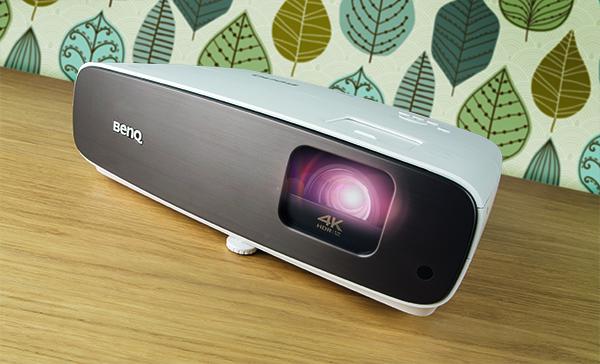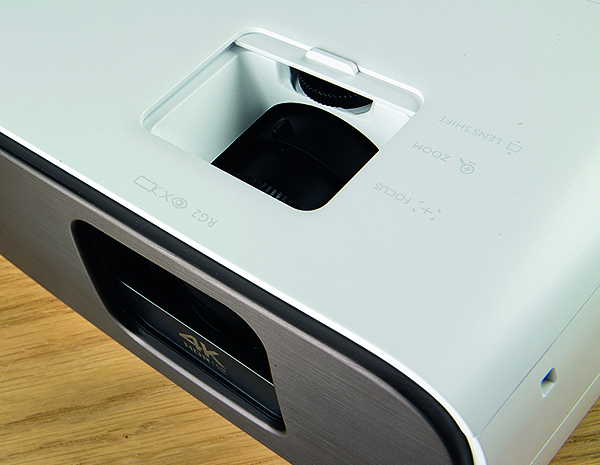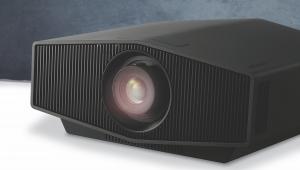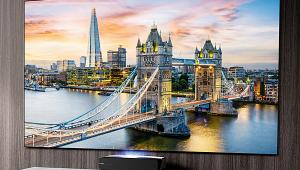BenQ CinePrime W2700 4K HDR projector review

 Colour us excited! The W2700 is the first single-chip DLP 4K home projector to aim to hit the wide colour space of the DCI-P3 standard used in digital cinema, and favoured by 4K UHD Blu-ray. According to BenQ
it falls a little short (reaching 95 per cent coverage),
but it's an intriguing development.
Colour us excited! The W2700 is the first single-chip DLP 4K home projector to aim to hit the wide colour space of the DCI-P3 standard used in digital cinema, and favoured by 4K UHD Blu-ray. According to BenQ
it falls a little short (reaching 95 per cent coverage),
but it's an intriguing development.
Wide Colour Gamut (WCG) support has long been common on higher-end UHD TVs, but until now affordable DLP projectors have only been able to cover regular REC.709. Thanks to the introduction of a new generation of Texas Instruments' XPR (Expanded Pixel Resolution) devices, that wider colour palette can be yours to project.
BenQ W2700 design and features
Design-wise the W2700 is immediately impressive. With its faux aluminium fascia, offset 10-element lens array and compact white cabinet, it’s entirely living room friendly.
Rear connections include two HDMI inputs (both of which are v2.0b and HDCP 2.2 compliant); a 12V trigger for syncing to an electric screen; an RS-232 serial control port; USB 3.0 media reader; and USB power jack. The provision of the latter allows you to directly attach an HDMI streaming stick to one of the HDMI inputs.
These rear connections are sandwiched between a 2 x 5W integrated stereo sound system, boasting CinemaMaster Audio+ DSP processing. While fine for casual impromptu use, this won’t satisfy home cinema enthusiasts for long. There are also digital optical audio and 3.5mm stereo analogue outputs.
The projector ships with a matching white remote control, with (orange) backlight provision. If you lose it down the sofa, there are onbody controls to access and navigate the main menu.
Providing illumination is a 145W UHP lamp, driven by proprietary algorithms which BenQ says maximise colour accuracy. Peak brightness is quoted at 2,000 Lumens, which is pretty much par for the affordable DLP course.
Setup is uncomplicated. Zoom and focus adjustment are manual, hidden behind a sliding hatch on the top of the unit, and it takes no time to frame and sharpen the image. The W2700 is a short-throw model, requiring between three and 3.5 metres for a 120in image, via a 1.3x zoom.
While the projector offers large button graphics when selecting inputs, the main interface is a more traditional tabbed box. Here you’ll find brightness, contrast, colour tint and sharpness sliders, and an advanced menu offering HDR brightness control to maximise snap depending on projected image size.

One welcome wheeze that comes with the W2700 is an individual calibration report. This has both the model name and individual serial number of the unit, and confirms compliance with 100 per cent of REC.709, and 95 per cent of DCI-P3. Every sample is measured and pre-adjusted for REC.709 in the BenQ factory to minimise colour variances between models.
Standard picture modes are Bright, Vivid TV, Cinema, Dark Cinema, and User/ISF Day and Night modes. While Bright is largely unwatchable, the Vivid TV option is certainly acceptable when viewing with some level of ambient light. That said, the basic Cinema mode is probably the best all-round performer with 1080p content.
When fed HDR, the projector locks into HDR mode, and the aforementioned picture presets are unavailable. Crafting colour is a six-segment RGBRGB colour wheel, which I found does a good job suppressing that old DLP bugbear rainbow fringing. At no point did I feel I was seeing the characteristic DLP trait.
BenQ W2700 performance
Overall, picture performance here is gorgeous for the price, offering supreme sharpness, authentic hues and solid dynamics. Our Planet (Netflix) proves to be perfect W2700 fodder. Shots of the Earth from orbit boast stunning vibrancy and detail; teeming underwater life is a riot of colour, while a hummingbird silhouetted against the sun gives the model a chance to show its HDR prowess.
 The PJ may not be native 4K, but image integrity is outstanding. Even when viewed up close, there’s no obvious pixel structure. The detail of skin tones and subtle textures are brought to the fore. There’s a good deal of brutal architecture on display in Amazon Prime thriller Hanna,
and it all exhibits better-than-1080p solidity and depth.
The PJ may not be native 4K, but image integrity is outstanding. Even when viewed up close, there’s no obvious pixel structure. The detail of skin tones and subtle textures are brought to the fore. There’s a good deal of brutal architecture on display in Amazon Prime thriller Hanna,
and it all exhibits better-than-1080p solidity and depth.
The projector is branded HDR Pro, reference to an optimised tone mapping technology used for both HDR10 and HLG content. As we've often said, PJs are not ideally suited for HDR as they can’t illuminate specific areas of an image in the same way a TV panel can – and, at worst, can darken the image down unacceptably in an effort to create dynamic headroom. But BenQ has achieved something special here. When Tim Roth is trying to tranquillize Edward Norton’s Hulk in the bottling plant (Incredible Hulk, 4K Blu-ray), there’s a veritable bonfire of bright highlights amongst the dark scenes. Gunshots spark in the gloom, and bullets ricochet brightly off storage tanks. There's no indication that the W2700 is dulling down its images to present brighter peak highlights.
Normally, I’d forgo a Dynamic Iris, to avoid image pumping and the scritchy sound of the iris adjusting, but on the W2700 it has a pronounced beneficial effect on the picture. In Hanna, computer screens suddenly glare with intensity when the Dynamic Iris is engaged.
So what of that DCI-P3 colour performance? Unlocking a wider colour gamut (the mode is selectable in the display menu) essentially requires the W2700 to reduce light output by around 50 per cent. It's a trade-off you'll need to come to terms with, either opting for enhanced brightness or colour handling, and its benefits are not always apparent.
Indeed, at times the low-brightness/WCG image can look quite flat in comparison to the PJ's REC.709 delivery – the stylised colour grading of American Made (UHD Blu-ray) doesn't equate to an obvious boost; switch Wide Colour gamut off and the overall brightness visibly increases, and the picture just looks livelier. It's a feature that warrants personal experimentation, and should only be used in a controlled light environment.
The W2700's new XPR DLP chipset brings another talent, in the form of improved black level performance. When our heroes escape from Hawkins Lab in Stranger Things (Netflix, Season 2, episode 8), through darkened corridors lit only by a flashlight, the projector manages to keep a watchable balance without crushing out the shadows. BenQ quotes a dynamic contrast of 30,000:1.
There are still limits to low-level fidelity from this well-priced beamer, though. As Chris Pratt hides behind a plinth from the raptor in the dinosaur museum (Jurassic World: Fallen Kingdom, 4K Blu-ray), there’s a void where shirt detail and shadow should co-exist.
Operating noise is perhaps the W2700's most notable flaw. In Normal mode it hits 30dB, and drops only to 28dB in Eco. There’s a cost to be paid in picture brightness, but the saving is still worth it.
BenQ W2700 verdict
The W2700 is a cracking UHD DLP projector that won’t break the bank. Its HDR handling is one of the most effective we’ve seen on a sub-£2,000 projector, and the overall design is neat and contemporary, making it a good choice for a living room or media room. Having the option of a wider colour gamut is also welcome, although the loss of brightness it brings is a challenge. Our only serious concern is operational noise. If you can manage this, then this budget 4K beamer is more than worth a look.
Specification
3D: Yes. Active 3D (glasses optional)
4K: Yes. 3,840 x 2,160 (Texas Instruments XPR)
HDR: Yes. HDR10; HLG
Connections:2 x HDMI inputs; optical digital audio output; 3.5mm audio output; 12V trigger; RS-232C; USB media reader; powered USB port
Brightness (claimed): 2,000 Lumens
Contrast ratio (claimed): 30,000:1
Zoom: 1.3x
Dimensions: 380(w) x 127(h) x 263(d)mm
Weight: 4.2kg
Features: Single-chip DLP system; built-in 2 x 5W speaker system with CineMaster Audio+; lamp-life rated at 4,000 hours (Normal), 10,000 hours (Eco), 15,000 hours (SmartEco); 1.13-1.47:1 throw ratio (100in at 2.5m); CinematicColor with claimed 95 per cent DCI-P3 coverage; HDR-Pro tone mapping; MEMC Motion Enhancer; ISF Day/Night presets; 10 per cent vertical lens shift
 |
Home Cinema Choice #351 is on sale now, featuring: Samsung S95D flagship OLED TV; Ascendo loudspeakers; Pioneer VSA-LX805 AV receiver; UST projector roundup; 2024’s summer movies; Conan 4K; and more
|























































